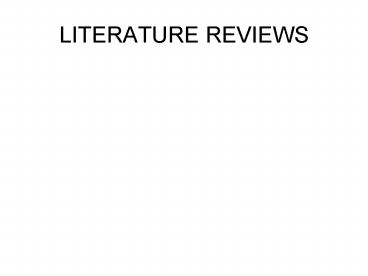LITERATURE REVIEWS - PowerPoint PPT Presentation
1 / 12
Title:
LITERATURE REVIEWS
Description:
... to weave eight hundred or more language groups into fifty-plus national ... Recent studies have tried to deal with this problem by focusing on the seven or ... – PowerPoint PPT presentation
Number of Views:61
Avg rating:3.0/5.0
Title: LITERATURE REVIEWS
1
LITERATURE REVIEWS
2
Invoking the literature Mark I
- The most intractable problem when discussing
contemporary African art is the continents
extreme cultural diversity. While colonialism and
postcolonial state-building have attempted to
weave eight hundred or more language groups into
fifty-plus national identities, there is still a
major problem in trying to write about the art in
the second half of the twentieth century in so
broad a region. Recent studies have tried to deal
with this problem by focusing on the seven or
eight best-known movements or workshops (Jean
Kennedys New Currents, Ancient Rivers
Contemporary African Artists in a Generation of
Change, 1992), following Ulli Beiers earlier
pioneering study (Contemporary Art in Africa,
1968) or by dividing the continents recent art
forms into categories based primarily on the
patrons for whom the art is made rather than on
history or geography (Susan Vogels Africa
Explores 20th Century African Art, 1991). More
recently, Andre Magnin and Jaques Soulillou
(Contemporary Art of Africa) selected about sixty
artists from all over the continent and divided
them into three groups (Territory, Frontier, and
World) according to the scope of each artists
vision, while the curators of Seven Stories about
Modern Art in Africa (held at the Whitechapel Art
Gallery in London in 1995) rejected the idea of
coverage altogether. They went back to most of
the same movements or experiments treated by
Beier and later Kennedy, but presented them from
the perspective of African curators, some of whom
were artists who had participated in the
movements they wrote about. This study, while
making use of each of these approaches and
drawing liberally upon them as sources, is
organised thematically. It attempts to deal with
some of the major issues surrounding the history
of contemporary African art since the 1950s, such
as patronage and the workshop, the development of
new genres, the commodification of art,
postcolonial art and national consciousness, and
the effects of globalisation. (Kasfir, 19997)
3
The Literature Review
- Creating an architecture
- Informing the study
- Scholars before researchers
- The author writes back
4
Role and purpose of the literature review
- Contextualization
- Critical engagement
- Explanation
- Generative
5
Locating literature
- Encyclopedias, dictionaries, handbooks, indices
- Electronic databases
- NISC, SA www.nisc.co.za
- Nexus http//www.hsrc.ac.za/nexus.html
- Wilson Art Index, published by SilverPlatter
www.silverplatter.com - Main authors, theorists
- Current research in subject journals
6
What to do with all the info?
- Present results of similar studies
- Relate your study to ongoing dialogue in the
literature - Provide a framework for comparing results of your
study with other studies - Invoke the literature appropriately
7
Invoking the literature Mark II
- Apart from brief citations in your
Introduction/Chapter 1, - Critical engagement with literature in Chapter
2/Literature Review - Explanation in your Chapter 5/Discussion of
findings
8
Writing up the Literature Review
- Thematically
- Chronologically
- Argumentatively
9
Skills
- Scholar
- Critical synthesizer
- Library literate
- Academic writer
- Then only, a research methodologist
10
Criteria to evaluate the quality of a literature
review
- Categories
- Coverage
- Synthesis
- Methodology
- Significance
- Rhetoric
11
Criteria
- Inclusion/exclusion
- What has been done/what needs to be done?
- Positioning of topic/problem in broader scholarly
literature - Historical context of the field
- Acquired/enhanced the subject vocabulary
- Complexity of the topic
12
(cont)
- New perspective on the literature
- Assess research methodologies in the research
literature - Related ideas in the research methodology
literature - Practical significance of the research
- Scholarly research significance
- Written with a coherent, clear structure that
supported the review



















![[PRESENTATION] How to write literature review PowerPoint PPT Presentation](https://s3.amazonaws.com/images.powershow.com/9158769.th0.jpg?_=20181012061)











